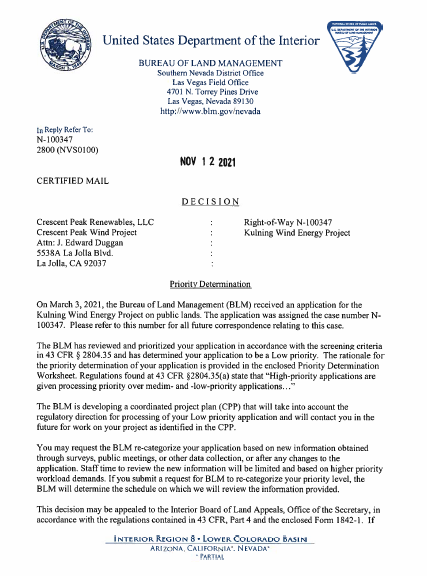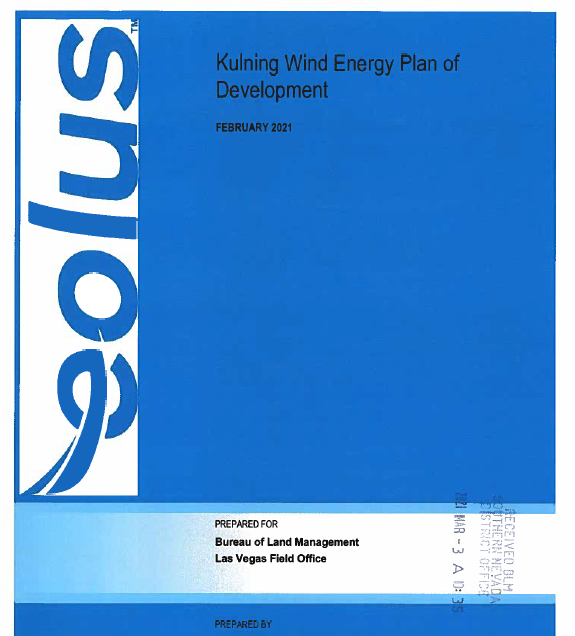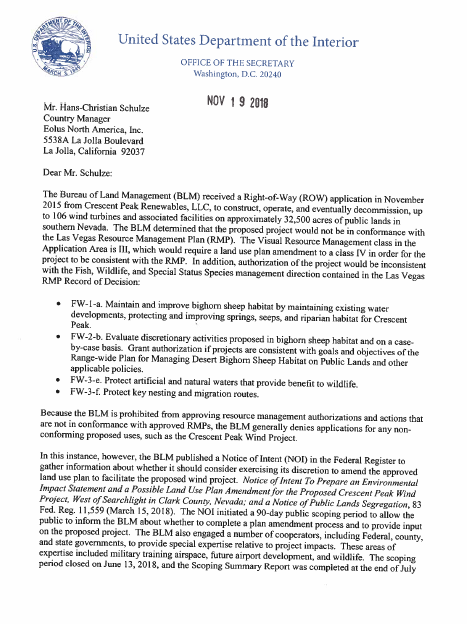Kulning Wind Project Placed on Low Priority Status
^Castle Mountains, NV-CA, site of proposed Kulning Wind Project.
November 14, 2021 - Searchlight, NV - The Bureau of Land Management (BLM) placed the unpopular Kulning Wind Project on a Low Priority Status. Low priority means this application will not move forward, and the project has been placed on the back burner.
Conservationists applauded the decision, since this wind project application lies in the midst of a dense and beautiful Joshua tree forest and rare desert grasslands, and overlaps with the Avi Kwa Ame National Monument proposal.
The Southern Nevada District of BLM, Energy and Infrastructure Team confirmed the decision on November 13, to Basin and Range Watch, attaching the letter for the BLM's Application Prioritization Decision for the Kulning Wind Energy Project.
Dowload a PDF of the letter >>here.
Zombie Project Rises Yet Again! New Crescent Peak Wind Energy Application: Kulning Wind Project
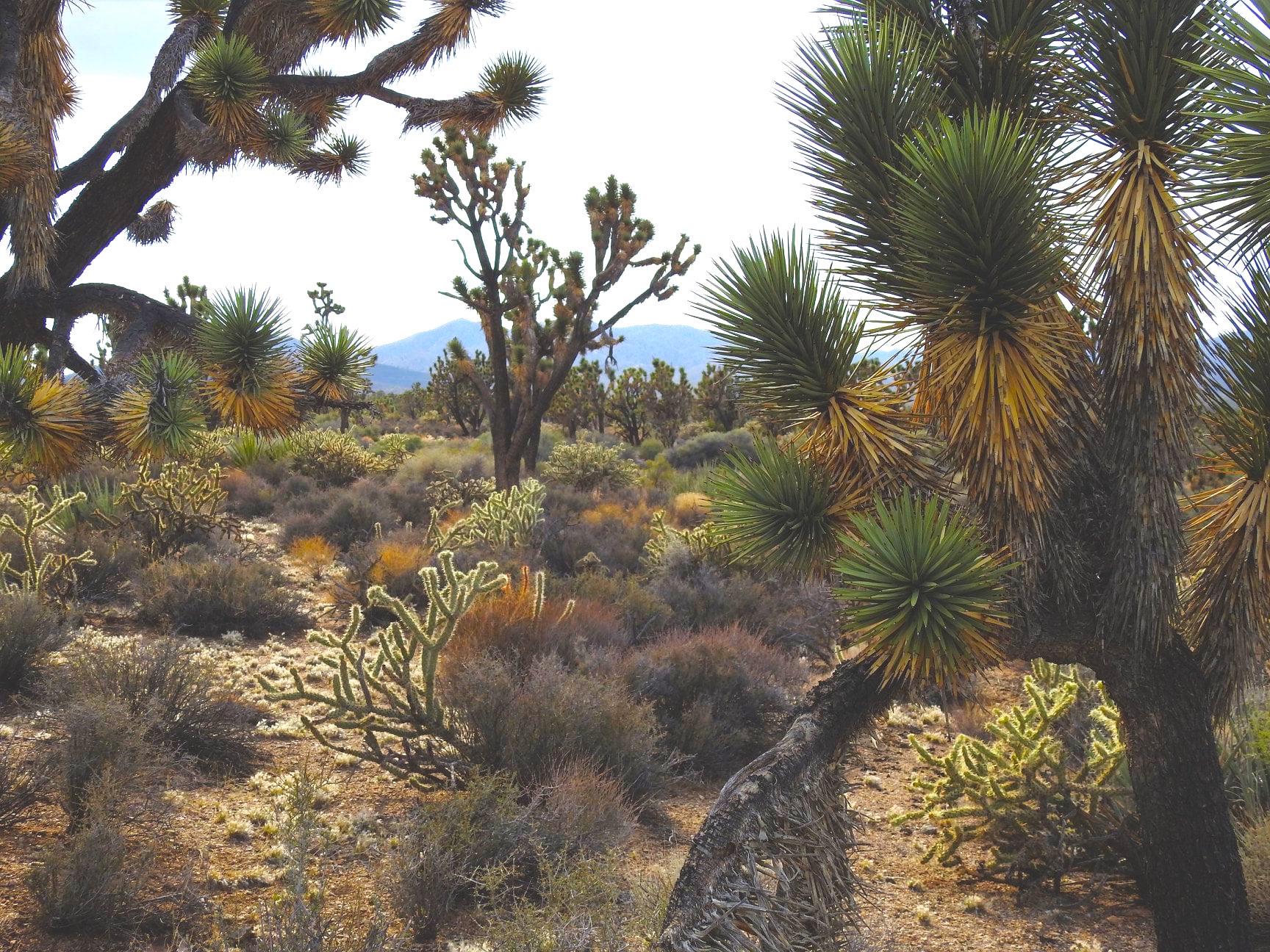
March 6, 2021, Clark County, Nevada - The Kulning Wind Project is newly proposed next to Wee Thump Wilderness on very high-value public lands next to the Castle Mountains National Monument in California, and within the proposed boundary of the nominated Avi Kwa Ame National Monument (our former wind-free-zone Area of Critical Environmental Concernnomination.
As many remember, Eolus Wind wanted to develop the Crescent Peak Wind Project next to the Mojave National Preserve on about 32,000 acres of Nevada public lands. Surprisingly, the Interior Department under the Trump Administraton canceled the environmental review over resource conflicts including blocked public access, visual impacts, wildlife impacts, hunting, and mining caims. Now the company is back with a brand new proposal for a 9,200 acre project with 68 turbine generators about 600 feet tall. They would also build a 29 mile transmission line to the Sloan Canyon substation. The project would be located next to Wee Thump Wilderness - a very dense Joshua tree forest. New turbines and transmission could easily spark a catastophic wildfire just like the 43,000 acre Dome Fire nearby last August. This area was denied protection as a National Monument by Senator Cortez-Masto in the latest Clark County Lands Bill. Yes, a wind project can still be built here.

^Map of the project, Wee Thump Wilderness.
Project info here: http://pucweb1.state.nv.us/.../DOCKETS.../2021-2/7622.pdf
The Kulning Wind Project Plan of Development can be downloaded as a PDF.
Crescent Peak Wind Project Updates
Nevada Public Utility Commission Rejects Application for Crescent Peak Wind Project
April 7, 2020 - Nipton CA and Castle Mountains reagion in NV/CA - Basin and Range Watch learned that the Nevada Public Utility Commission denied a new application by Eolus Wind in their attempt to restart the Crescent Peak Wind Project (which was also denied a Right-of-Way by Bureau of Land Management). This ill-sited wind project appears dead.
Proposed National Monument South of Las Vegas Snuck Into Clark County Lands Bill
February 17, 2020 - Some environmental groups have proposed a 384,000-acre monument along Nevada’s southern boundary next to Castle Mountain National Monument in California, as part of a deal to allow a legislative land swap of public lands to private developers seeking to build new cities near Jean NV. See the article in the Las Vegas Sun: https://lasvegassun.com/news/2020/feb/16/proposed-national-monument-south-las-vegas-boost/?fbclid=IwAR1-SQ6-hPbqkHV4xNBq9ErSVk9_ozg0OeXgW6_GJXTG5MC0BbcEl5qjQmM
The monument proposal is partly based on Basin and Range Watch's earlier nomination for the same area to be a wind-free zone and Area of Environmental Concern (ACEC). The monument proposal takes some of our language on the regions unique Mojave-Sonoran desert grasslands and dense Joshua tree woodlands home to rare Nevada birds such as gilded flicker, curve-billed thrasher, and Harris hawk.
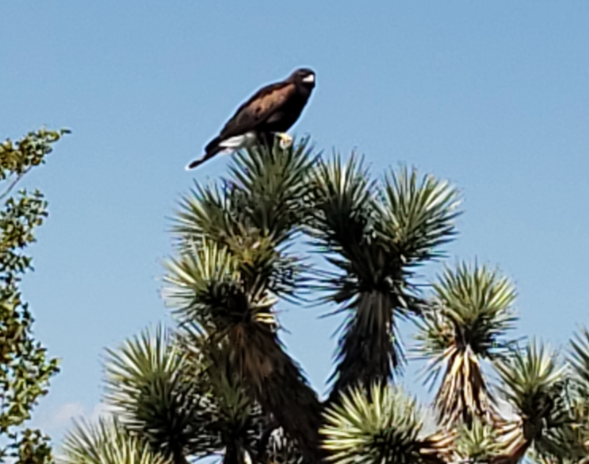
^Photo of a Harris hawk near Searchlight NV, taken in March 2020 by Judy Bundorf.
While Basin and Range Watch supports the idea of a new national monument in this area, we can not get behind the legislation that this would be added to. In exchange for a few wilderness areas and a National Monument, the Clark County Lands Bill would sell off about 45,000 acres of public lands between Las Vegas and Jean, Nevada. This would bring more and more urban sprawl, pollution and habitat fragmentation to the Mojave Desert - one of the most endangered regions in the world. This would also push species like the desert tortoise closer to extinction. We would also like to point out that we have proposed conservation for the region by opposing and stopping the Searchlight Wind Project and were very instrumental in stopping the Crescent Peak Wind Project. We asked the Bureau of Land Management to protect the area from large-scale energy and proposed a conservation designation. But we never agreed to trade it for other valuable public lands. Please oppose the tragic Clark County Lands Bill. Quid pro quo wilderness is not the way to do this.
Eolus Pushing Wind Application for Crescent Peak
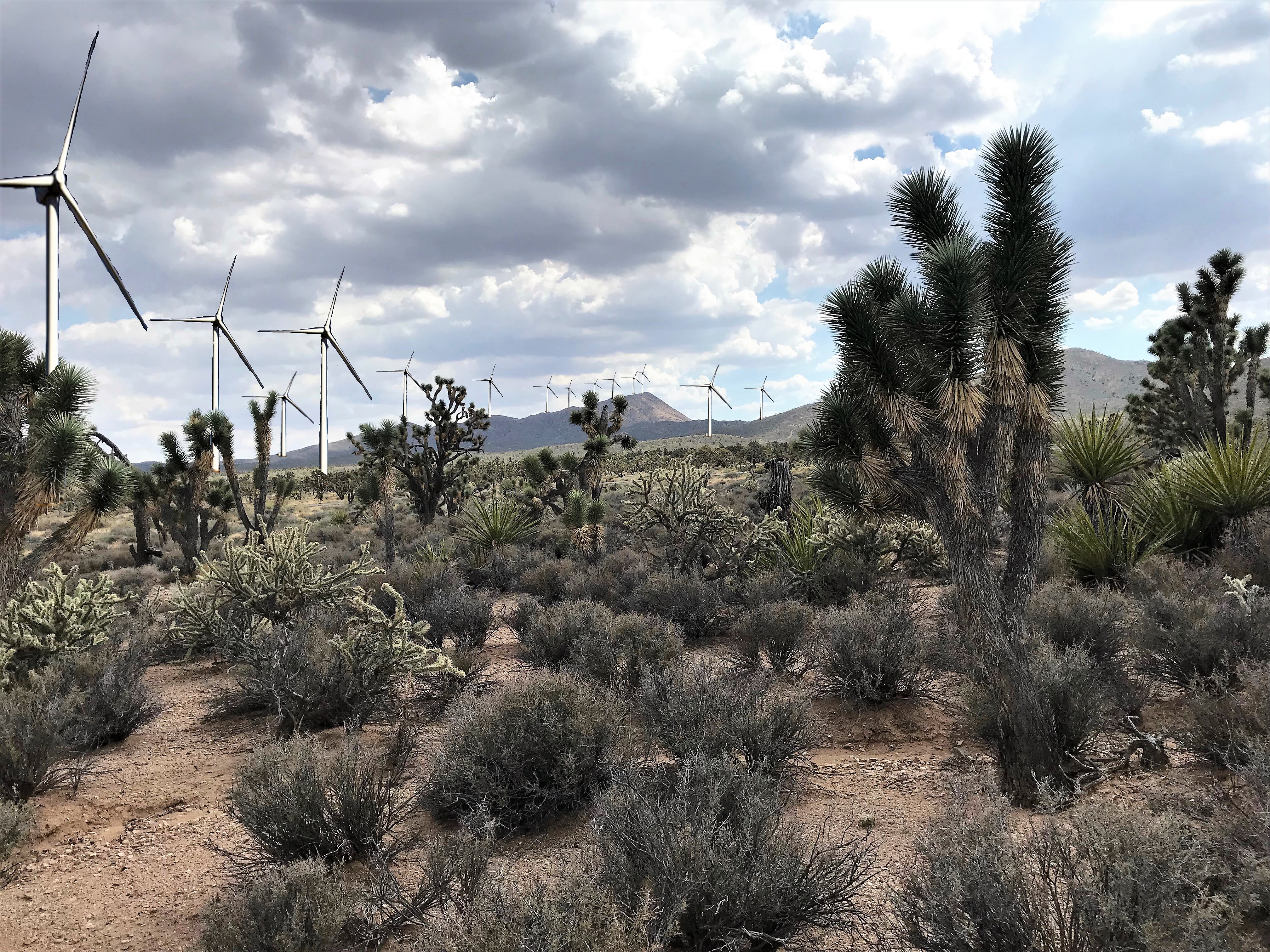
^Simulation of industrial wind project next to Wee Thump Joshua Tree Wilderness, with Crescent Peak in the distance.
November 4, 2019 - Searchlight NV - A new application for the Crescent Peak Wind Project is being pushed by the Swedish company Eolus, despite a letter on November 19, 2018, from the Bureau of Land Management (BLM) Assistant Secretary of Land and Minerals Management stating that this application could not be processed due to non-conformance with the approved Las Vegas Resource Management Plan (RMP) and it conflicts with resource uses, military training missions, and county development. Subsequent to this the local Las Vegas BLM office sent Eolus a letter rejecting the application and closing the casefile for this wind project right-of-way application.
A more strongly-worded and clear rejection of this wind project in any form could not be more obvious, while accepting the very high value of natural and recreational resources in this region that need added protection. We have been advocating for a wind energy-free zone from Lake Mead National Recreation Area to the california border across this southern tip of Nevada for years, in order to protect the Piute Valley, Wee Thump area, Spirit Mountain viewshed, and Walking Box Ranch region in perpetuity for the public.
We have obtained files in a Freedom of Information Act (FOIA) request showing the revised mitigation plans and updated application, as well as emails between agency staff telling everyone to withold information from Basin and Range Watch represented by co-founder and director Kevin Emmerich (which should be publicly available). Think what the federal agencies are witholding on oil and gas public lands leases and projects.
We also Received a FOIA request that included a revised Plan of Development (POD) from August 2019, after the Interior Secretary's office had sent the wind company a letter to cancel the project. Eolus seems to not take the letter at its face value, and is trying to push to build an industrial wind project in this high value public lands area anyway.
The wind company claims it would reduce impacts to Wee Thump Joshua Tree Wilderness Area in a letter to the BLM (obtained in a FOIA request), yet its recent maps show wind turbine generators surrounding two side of the Wilderness, up to its boundary, as well as a new 24-mile long 230-kiloVolt transmission line gen-tie through the Joshua tree savanna. Each wind turbine generator would be 599 feet high, and impact the rare gilded flicker populations here, as well as many other birds only found in Nevada in this Mojave desert grassland-Joshua tree savanna.
In an email obtained by FOIA dated August 2, 2019, Eolus representatives told BLM they would mitigate damaging impacts to the area with mirigation that included minimizing lighting on the wind turbine generators, contructing bighorn sheep water guzzlers, and adjusting the proposed boundaries of the project to avoid Castle Mountains National Monument. We see that in the maps below.

^Revised Crescent Peak Wind Project obtained by FOIA, showing a southern area of wind development eliminated by the company next to the new Castle Mountains National Monument in California, but not next to Wee Thump Joshua Tree Wilderness Area to the north. The developer is proposing to reduce the wind project from 32,531 acres of public lands to 28,896 acres. This is still unacceptable in this region full of rare birds, bighorn sheep, golden eagle nests, and desert tortoise, as well as recreation.

^Wind turbine generators are still proposed in a revised Plan of Development next to Wee Thump Joshua Tree Wilderness Area. A new substation would be built right on a western corner of Wee Thump. Map obtained by FOIA by Basin and Range Watch, dated August 2019.

^A sample of the revised August 2019 POD from the wind developer still pushing this ill-sited application in southern Nevada between Seasrchlight and the California border along the Mojave National Preserve and South McCullough Wilderness Area.

^Wee Thump Joshua Tree Wilderness Area.
Another letter confirming the unmitigable importance of this area to wildlife is from a BLM wildlife biologist team using Nevada Division of Wildlife (NDOW) comments toemphasis the need to keep this area free of wind energy projects. We obtained this memo by FOIA, and the agency clearly states that the Castle mountains and Crescent Peak area prvides a crucial linkage corridor to desert birghorn sheep between southern California and southern Nevada. The bighorn sheep daily and seasonal movements would be "devastated" by a wind project constructed here. The development of so many new roads could bring in all-terrain vehicle use, disturbing the bighorn populations, and severing this connectivity corridor.
Crescent Peak Wind Zombie Project?
^Chairwoman Ann Pongracz of the Nevada Public Utilities Commission, at the preheraing conference.
August 11, 2019 - Las Vegas NV - Basin and Range Watch learned that the applicant for the Crescent Peak Wind Project, the Swedish company Eolus, may be trying to bring the project back from the dead.
In 2018, then-Interior Secretary Zinke's office had written a letter instructing the Bureau of Land Management (BLM) to cancel the project, due to significant environmental and recreational concerns in the Castle Mountains region of southern Nevada, where the large wind project was proposed. The wind turbines were slated to be constructed in unique Mojave Desert grasslands and Joshua tree woodlands next to the California border, alongside Mojave National Preserve and the new Castle Mountains National Monument.
We learned that Eolus and their attorney had scheduled a prehearing conference on August 6 before the Nevada Public Utility Commission (PUC) to argue the procedural process of continuing their application. We were there are observers, and Basin and Range watch was entered into the administrative record as "present."
Attorney Linda Bullen, representing the wind company, videoed in from Reno, along with a representative of Eolus.
Bullen asked for a closed prehearing because of the purported confidentiality of certain information in the application. The staff atttorney representing the PUC, Shelley Cassidy, said she had seen this material, and it did not warrant confidential status. It would be in the public interest to see this material openly. Bullen countered that the information was confidential business information, and "ongoing disussions." Cassidy came back that the information was not claimed as privileged or trade secrets, and based on their legal analysis it was not confidential.
Commissioner Pongracz said she would make a determination on this in the next few days.
Cassidy argued that Secretarial letter of August 19, 2018, denying the wind project, was indeeded a final agency action. Therefore the case was closed. She also called BLM to clarify, and the Las Vegas office told the PUC that they did not intend to issue anything further, the denial order "came from the boss." So there was nothing further that the BLM could issue.
Linda Bullen, however, repeatedly argued that the letter did not terminate the wind project, there was no direct communication from BLM to them.
Chairwoman Pongracz asked if Bullen had viewed the BLM web page on the project update that says BLM is denying the Right of Way for the wind project?
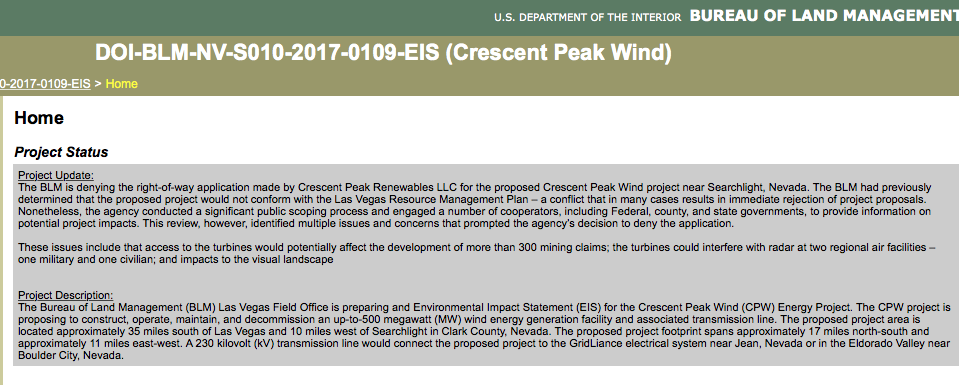
This BLM eplanning page reads: Project Status, Project Update:
The BLM is denying the right-of-way application made by Crescent Peak Renewables LLC for the proposed Crescent Peak Wind project near Searchlight, Nevada. The BLM had previously determined that the proposed project would not conform with the Las Vegas Resource Management Plan – a conflict that in many cases results in immediate rejection of project proposals. Nonetheless, the agency conducted a significant public scoping process and engaged a number of cooperators, including Federal, county, and state governments, to provide information on potential project impacts. This review, however, identified multiple issues and concerns that prompted the agency’s decision to deny the application.
These issues include that access to the turbines would potentially affect the development of more than 300 mining claims; the turbines could interfere with radar at two regional air facilities – one military and one civilian; and impacts to the visual landscape.
Linda Bullen responded that this posting does not reflect the project. She did not think the Zinke letter represented a final agency action. When asked by the PUC if Eolus planned to legally challenge this, Bullen said no, they were not.
Counsel for the PUC Cassidy pushed to have the Crescent Peak Wind Project application dismissed. She said already 9 months had passed since the Interior letter. Linda Bullen requested 3 more months, to try to find clarification from the Department of Interior apparently. Cassidy wanted a stipulation that if no such information was forthcoming by the end of 3 months, that the applicant would agree to automtaically withdraw and end this case. Bullen agreed.
Commissioner Pongracz, listening carefully to the legal arguments, decided to have a hearing on November 5, 2019, to hear any testimony about whether this project should be dismissed. Attorney Cassidy pushed fro immediate dismissal, but said she would agree to 3 more months. She said she not need to provide any testimony, and that that this application dismissal would be solely as a legal argument. Attorney Bullen for Eolus said she might need to provide testimony. But she also said that if the environmental review process was not re-initiated by that time, then they would withdraw.
Distributed Energy Resources Are the Alternative to Public Lands Energy Devlopment
December 9, 2018 - We thank the Las Vegas Review-Journal for publishing our response in its entirety, to their editorial. We need a wider dissussion about this important topic.
Read our Opinion piece here: https://www.reviewjournal.com/opinion/commentary-not-just-any-clean-energy-project-in-nevada-is-acceptable-1546144/
Interior Letter Canceling Wind Project Notes High Value Area for Bighorn Sheep, Eagles
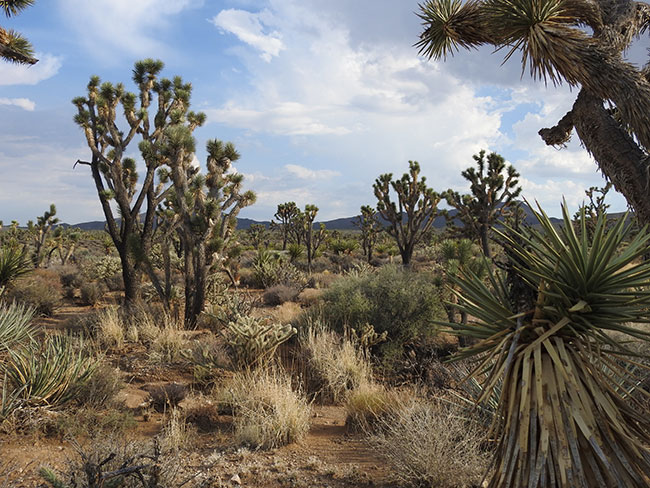
^Wee Thump Joshua Tree Wilderness Area, with Crescent Peak in the background--wind turbines would have lined that ridge.
December 7, 2018 - Southern Nevada - Basin & Range Watch, working with Western Watersheds Project (WWP), obtained the letter from the Department of Interior cancelling the Crescent Peak Wind Project. It notes the high resource value of this area.
The Interior letter can be viewed as a >>PDF.
The proposed 32,000-acre Crescent Wind Protect would have had up to 240 giant wind turbine generators on land managed by the Bureau of Land Management in southern Nevada along the California border. After making several field visits, WWP wrote detailed comments and attended public meetings to oppose the Crescent Peak Wind Project along with Basin and Range Watch (BRW). Attorney Dave Becker gave input to our comment letter. A large coalition of conservation groups, tribes, and local individuals opposed this project. Our letter emphasized the beautiful visual resources of the area, which lies between Wee Thump Joshua Tree Wilderness Area, the South McCullough Wilderness Area, and three national park units: Mojave National Preserve, Castle Mountains National Monument, and Mojave Trails National Monument. Our comments also emphasized the extremely high biological resources present here. WWP and BRW hosted a weekend Bioblitz for the public to gather observations of the diverse plant and animal species in the area. Nevada Department of Wildlife biologists came to the bioblitz and surveyed for Gila monsters, which may inhabit these desert grasslands. Golden eagles nest in the cliffs of the Castle Peak Mountains here, where wind turbines were proposed.
The area was previously grazed by cattle as the Crescent Peak Allotment. This allotment was closed to protect desert tortoise and desert bighorn sheep through the Clark County Multi-Species Habitat Conservation Plan. The historic Walking Box Ranch was purchased by conservation funds and is now in the process of becoming a BLM visitor contact station.
The Right-of-Way was canceled by the Department of the Interior, based on high resources values. These extensive Joshua tree woodlands and rich Mojave desert grasslands that have been recovering from livestock grazing, will now be better protected from new roads and energy project development. But the area still needs a higher level of protection, such as designation as an Area of Critical Environmental Concerns. WWP, BRW, and other conservation groups are continuing to work towards that goal.
An AhaMakav Cultural Assistant poinedt out the misspelled word for Spirit Mountain in the letter, its spelled ‘Avi kwa’ ame. Ami Kwanze is not correct.
Here are the exact Code of Federal Regulations Interior quotes to justify canceling the Right-of-Way:
43 CFR 2804.25(e)
(2) If your application is for solar or wind energy development:
(i) Hold a public meeting in the area affected by the potential right-of-way;
(ii) Apply screening criteria to prioritize processing applications with lesser resource conflicts over applications with greater resource conflicts and categorize screened applications according to the criteria listed in § 2804.35; and
(iii) Evaluate the application based on the information provided by the applicant and input from other parties, such as Federal, State, and local government agencies, and tribes, as well as comments received in preliminary application review meetings held under § 2804.12(b)(4) and the public meeting held under paragraph (e)(2)(i) of this section. The BLMwill also evaluate your application based on whether you propose to sitethe development appropriately (e.g. outside of a designated leasing area or exclusion area) and whether you address known resource values discussed in the preliminary application review meetings. Based on these evaluations, the BLM will either deny your application or continue processing it.
and
§2804.26 Under what circumstances may BLM deny my application?
(a) BLM may deny your application if:
(1) The proposed use is inconsistent with the purpose for which BLM manages the public lands described in your application;
(2) The proposed use would not be in the public interest;
...
(5) You do not have or cannot demonstrate the technical or financial ca- pability to construct the project or operate facilities within the right-of-way;
https://www.gpo.gov/fdsys/pkg/CFR-2011-title43-vol2/pdf/CFR-2011-title43-vol2-part2800.pdf
Editorial Attacks Basin and Range Watch as "NIMBYs"
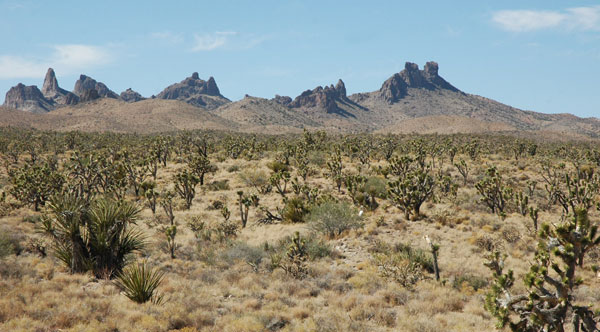
December 5, 2018 - Southern Nevada Desert - In an Editorial today by the Las-Vegas Review Journal, we were chided for our efforts to conserve the beautiful wildlands south of Las Vegas in southern Nevada, an area beloved by locals, tourists, hunters, bird-watchers, and others. You can read it here.
Our repsonse:
We Support Renewable Energy: Distributed Generation
In response to the editorial in the Las Vegas Review Journal dated December 5, 2018, we would like to point out that Basin and Range Watch supports renewable energy and increased Renewable Energy Portfolio Standards in Nevada. But these must be designed in a smart way, not large-scale developments in the most sensitive natural wildlands that are habitat for desert tortoises, golden eagles, bighorn sheep, and the largest Joshua tree woodland in the state next to National Monuments and Wilderness Areas.
As renewable energy technologies mature after more than 10 years of build-out in the desert, we should be able to have a more critical and nuanced approach to siting projects, and to crafting policies. These should include a much higher amount of energy efficiency policies and advanced Distributed Energy Resources (DERs), such as rooftop solar plus battery storage.
That net energy metering policies in Nevada have undergone a roller-coaster should be considered when relying solely on public lands for utility-scale solar and wind development. If rooftop solar policies were crafted that incentivize, instead of punish, residential solar generators, then an RPS could be vastly increased without the destruction of biologically rich Mojave Desert habitats on public lands.
We need to fight climate change with better policies, quality of decisions, not simply blind quantities of renewable energy projects placed willy-nilly on the landscape.
Any RPS in Nevada should have at the very least, a 33% carve-out requiring rooftop solar plus battery storage, solar projects built on disturbed lands such as empty lots in the built environmental, and increased energy efficiency. It’s time for a smarter renewable energy push.
Rooftop Solar is the Way To Go
Cleantechnica had this to say recently: If other states follow the California proposal to require solar on all new home builds, the United States could have three times as much solar power as it does now, reckon analysts at Environment America who have produced a new report on the issue. https://cleantechnica.com/2018/12/04/new-home-solar-laws-could-triple-us-solar-base-by-2045/
New Grid Architecture Needed
And here is an excellent, although long and technical, article recently from David Roberts, on how the grid should move from top down to bottom up: https://www.vox.com/energy-and-environment/2018/11/30/17868620/renewable-energy-power-grid-architecture?utm_campaign=drvox&utm_content=chorus&utm_medium=social&utm_source=twitter
BREAKING: Crescent Peak Wind Project Canceled!
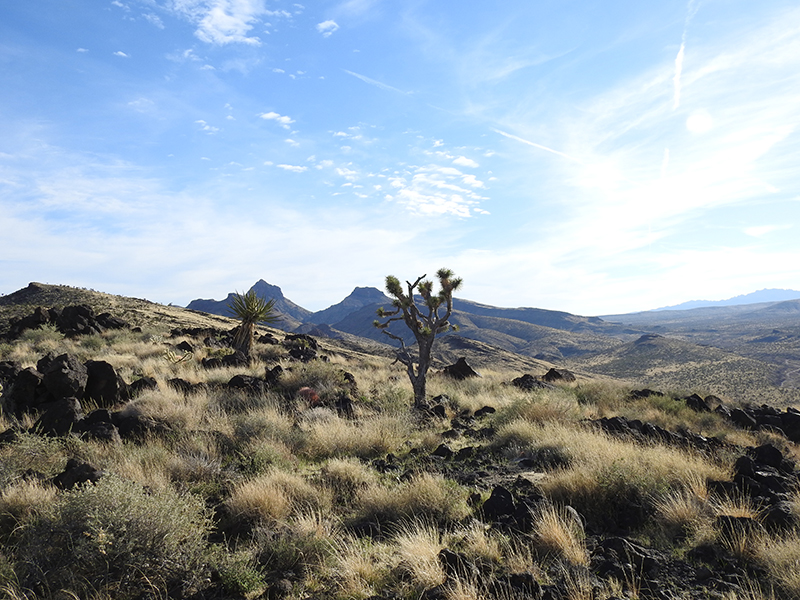
^Castle Mountains, Nevada. Site of a meteorological tower for a proposed wind project.
November 30, 2018 - Southern Nevada - UPDATE - The Las Vegas Review-Journal interviews Basin and Range Watch and confirms with BLM that the project is canceled: https://www.reviewjournal.com/news/politics-and-government/blm-rejects-massive-wind-farm-along-california-nevada-border-1539541/
The Department of Interior canceled the Crescent Peak Wind Project in southern Nevada next to Castle Mountains National Monument and South McCullough Wilderness Area, the Bureau of Land Management (BLM) confirms to Basin and Range Watch. Thanks to a large local grassroots push to halt this ill-sited wind project and protect the rare desert grasslands and biodiverse Joshua tree woodlands here. Interior cited recreational values of this area, mining and hunting, as well as the BLM's cancellation of its Southern Nevada Resource Management Plan. Historic resources, tribal concerns and archaeology were also concerns.
Our grassroots network helped write many letters to Interior Secretary Ryan Zinke telling him this area was a valuable area for recreation. Hunters wrote that this place was a significant area. Birdwatchers come here to see the unusual gilded flicker.
The Reno state office of the Nevada BLM issued this statement today:
"Here is the BLM statement regarding this project:
"The BLM is denying the right-of-way application made by Crescent Peak Renewables LLC for the proposed Crescent Peak Wind project near Searchlight, Nevada. The BLM had previously determined that the proposed project would not conform with the Las Vegas Resource Management Plan – a conflict that in many cases results in immediate rejection of project proposals. Nonetheless, the agency conducted a significant public scoping process and engaged a number of cooperators, including Federal, county, and state governments, to provide information on potential project impacts. This review, however, identified multiple issues and concerns that prompted the agency’s decision to deny the application.
"These issues include that access to the turbines would potentially affect the development of more than 300 mining claims; the turbines could interfere with radar at two regional air facilities – one military and one civilian; and impacts to the visual landscape."
Rudy Evenson
Acting Chief of Communications
Bureau of Land Management - Nevada
Office: 775-861-6629 Cell: 775-223-3158
revenson@blm.gov | www.blm.gov/nv
Follow BLM Nevada on Social Media
Twitter | Facebook| YouTube| Flickr
Company Meeting in Searchlight and More Updates
ld ^Eolus made these simulations of what their proposed wind project woud look like near Walking Box Ranch on the Crescent Peak area of southern Nevada. Note the new roads carving up the ridge. Many Joshua trees would have to be removed in order to get these massive towers and rotors delivered on over-sized truck loads. The area is presently almost roadless and has Lands with Wilderness Characteristics.
October 23, 2018 - Searchlight NV - The Bureau of Land Management (BLM) told us they have delayed the release of their Environmental Impact Statement on the Crescent Peak Wind Project to January 2019.
According to FOIA (Freedom of Information Act) documents obtained by Basin and Range Watch, BLM is not even going to consider a No Wind Alternative in their upcoming environmental review.
Of particular interest is Item 4 - under section I. Quoted here:
"Last Thursday, got final direction that the no build/wind exclusion alternative could not be retained in this EIS and should be listed as considered, but not carried forward."
Under the National Environmental Policy Act, a reasonable range of alternatives muct be analuzed by the federal agency in any proposed action. BLM will also not consider our Castle Mountains Area of Critical Environmental Concern nomination for similar reasons. But these are not good reasons, in our opinion.
^Castle Mountains, Nevada, at sunset.
Another interesting FOIA discovery relates to golden eagles. BLM lost on our Searchlight Wind Project lawsuit, where the court ordered the right-of-way vacated.
The FOIA correspdondance records : "POWER, BLM, and NDOW to meet to discuss how to address eagles in EIS. Mark to set up meeting w/ POWER tomorrow. Mark to pull responses to Searchlight lawsuit."
We attended a meeting put on by Eolus and its contractors on September 25 at the Searchlight NV community center. The meeting was apparently to try to garner support for the giant wind project near the community, in the heart of beautiful and biodiverse desert mountains next to Wee Thump Joshua Tree Wilderness Area and Castle Mountains National Monument over the border in California.
The great majority of local residents did not approve of a massive energy development in their rural wildlands and desert.
Alan O'Neill, former superintindent of Lake Mead National Recreation Area, also attended the meeting put on by Eolus and their contractors. He put together a must-see Fact Sheet of wind project data, the latest design and proposals, and photographs of the natural desert area.
On an Eolus Excel spreadsheet to the Federal Aviation Adaministration (FAA), it lists the towers as being 591 feet tall. That is twice as tall as the tallest tree in the world--the coastal redwood (Sequoia sempervirens). The Statue of Liberty is only 305 feet. The Great Pyramid of Giza is 455 feet tall. The Washington Monument is 555 feet. The size of the turbines (up to 4.8 MW) are also above average for inland turbines and about average for offshore. Those are a very significant size.

^Proposed wind turbine generator Eolus wants to use at Crescent Peak.
Visual simulations were shown as posters in the community center. Most of their visual simulations were about as bad as the attached photo. This would be the view from the community center. They even had a sign that said "stand back 5 feet to view these visual simulations."
A wind project here would be a very poor location, as the Wee Thump Joshua Tree Wilderness Area is a bird hotspot, the only place in Nevada where gilded flickers reside. See our expedition to find and photograph gilded flickers >here.
At the meeting, Ed Duggan of Eolus came up to us and tried to ask if we would negotiate moving wind turbines around to supposedly avoid resource impacts (commonly referred to as 'micrositing'), and he and said, "You don't have to sue us. There are options besides litigation. We can easily move wind turbines away from Wee Thump." Basin and Range Watch smiled.
FOIA Updates

^Meteorological tower placed to measure winds (or lack thereof) for the proposed Crescent Peak Wind Project, on the Castle Mountains, Nevada.
September 12, 2018 - Nevada/California border - Obtained by Freedom of Information Act (FOIA) in July 2018 by Basin and Range Watch, these agency emails show concern about golden eagles in the Crescent Peak and Castle Mountains area of Nevada, and concern noted by Native American tribes about impacts to Spirit Mountain.
A wind exclusion designation is conisdered a valid alternative to analyze. But we are unclear why an Area of Critical Environmental Concern (ACEC) alternative is not. We have been told by the Bureau of Land Management (BLM) that this is not an "action alternative." Yet interpretive signs and restoration of the area could be considered "actions." The FOIA emails say the ACEC alternative "is considered, but not carried forward due to not meeting 'relative importance' for the entire area." We disagree with this statement. This area is incredibly significant in the region, with very high biodiversity, historical and cultural treasures, and scenic beauty. Some parts have lands with wilderness characteristics.
In this email thread, BLM reports that Crescent Peak Renewables (CPR) met with the Searchlight Town Advisory Board, after scoping had ended for the wind project. They say: "Meeting was structered such that the board could ask questions (they didn't), but that the public could not" (emphasis ours). This is public land, and the public should be included in all phases of this project.
We expect the draft Environmental Impact Statement to be issued by BLM in October or thereabouts. It may have a short public comment period, 45 days, and we will be ready to mobilize our supporters to comment.
FOIA Updates
May 7, 2018 - Nevada/California border - See a December 30, 2015 letter by the wind developer trying to push the Bureau of Land Management to get the application process going. See this Desert Tortoise survey proposal, and an email concerning Visual Resources. Obtained by Freedom of Information Act in May 2018 by Basin and Range Watch.
Explore the Amazing Castle Mountains Nevada Area in a Bioblitz
UPDATE May 4, 2018 - See the article in the Las Vegas Sun.
UPDATE April 16, 2018 - The battle is heating up to conserve this remote desert grassland and Mojave Joshua tree savanna along the border of Mojave National Preserve and Castle Mountains in Nevada. See our interview in The Nevada Independent:
"It's not the windiest place..." says the developer, but it is one of the most biodiverse places in the Mojave Desert.
Basin and Range Watch, along with many supporters, friends, and fellow organizations, are nominating an Area of Critical Environmental Concern on land managed by the Bureau of Land Management (BLM) in the Piute Valley, Castle Mountains, Crescent Peak, and McCullough Mountains of Nevada, along the border of California and the Mojave National Preserve and the new Castle Mountains National Monument. These lands are primarily located in Clark County, Nevada and the bioblitz covers the "place" named Castle Mountains Nevada over roughly 38,000 acres in extent. As part of the revision of the BLM Southern Nevada Office Resource Management Plan, we are taking this opportunity to seek heightened conservation status for this area, which is threatened by urban development, mining, and the Crescent Peak Wind Project proposal.
Come out to the Bioblitz on the weekend of April 28-29, the launch date! We are keeping the project into November so we can all return at our leisure to add observations when we can. So please feel to send us any observations if you do not upload them to iNaturalist. More >>here.
Crescent Peak Wind Project to Start Review on Border of Castle Mountains
^No place for a wind project: border of Nevada and California with Joshua trees and desert grassland, next to Castle Mountains National Monument.
March 15, 2018 - Southern tip of Nevada - The 32,000 acre Crescent Peak Wind Project, located right on the border of Mojave National Preserve and the new Castle Mountains National Monument is now undergoing a 90 day scoping period in the Federal Register. Notice of Intent here: https://www.gpo.gov/fdsys/pkg/FR-2018-03-15/html/2018-05273.htm
The impacts to the scenery will be significant, so that the Bureau of Land Manageent (BLM) will need to downgrade the Visual Classification to approve the project.
We have submitted a nomination to the BLM to designate the entire project site as an Area of Critical Environmental Concern. This will be looked at under the review for the Southern Nevada Office Resource Management Plan.
Conservation Designation Proposed by Groups
February 5, 2018 - Basin and Range Watch wrote a petition to Bureau of Land Management (BLM) to nominate public lands in the Piute Valley, Castle Mountains, New York Mountains and McCullough Mountains for status as an Area of Critical Environmental Concern (ACEC). These lands are
primarily located in Clark County, Nevada and are roughly 38,000 acres in extent. Part of the revision of the Southern Nevada Resource Management Plan, we are taking this opportunity to seek heightened conservation status for this area, which is threatened by urban development, mining, and the Crescent Peak Wind Project proposal.
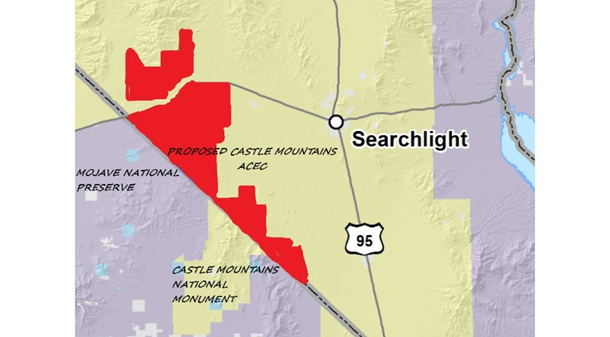
^Map of proposed ACEC.
The Castle Mountains contain a unique arid grassland community in both California and Nevada. This area contains the only stands of diverse C4 perennial grasslands west of the Colorado River, subtropical grasslands that are normally found in the Sonoran Desert uplands in Arizona and Mexico. Grass species common in this plant community flower and seed during the warm seasons of summer and fall, especially after strong monsoon rainfall events. Normally found in the Sonoran Region, and even as far east as the Great Plains, grasses such as Black grama (Boutelua eriopoda), Blue grama (B. gracilis), Sideoats grama (B. curtipendula), are found in this corner of the Mojave Desert uplands, ranging into a small area of adjacent California in the Castle Mountains National Monument and Mojave National Preserve. This arid summer monsoon grassland community grades below into diverse creosote scrub (Larrea tridentata) and above into Blackbrush scrub (Coleogyne ramosissima) and one of the world’s largest Joshua tree woodlands (Yucca brevifolia), providing a
wide diversity of habitats for reptiles, birds, and mammals.
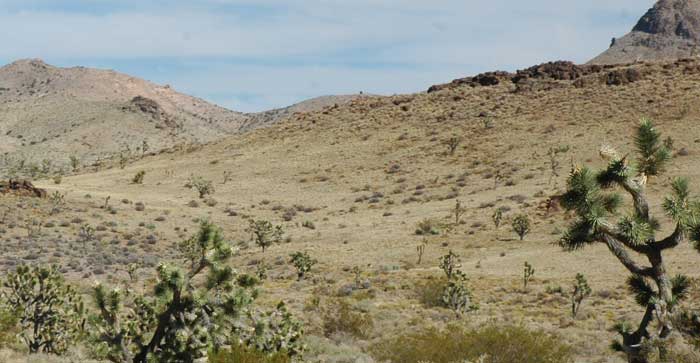
^Unique desert grassland with Joshua trees in the Castle Mountains.
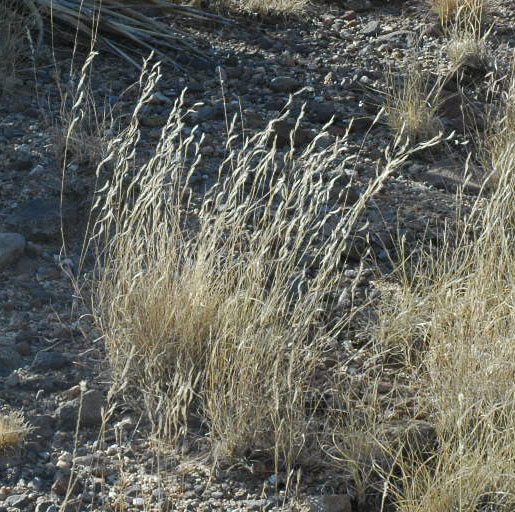
^Blue grama (Bouteloua gracilis) in the Castle Mountains.
The new ACEC would be adjacent to the existing Piute-ElDorado Area of Critical Environmental Concern which was established to protect the desert tortoise. While the upper elevations of the ACEC are too high to be good tortoise habitat, the lower eastern half would be quite suitable and protect connectivity habitat for the species. The region also contains the highest known density of golden eagles in the region. In February, 2016, President Obama signed the new Castle Mountains National Monument into law. The Monument protects 22,000 acres of public lands on the California side and is surrounded by the Mojave National Preserve, the third largest unit of the National Park system in the Continental United States. The scenic Castle Peaks are adjacent to this ACEC proposal. On the Nevada side is Walking Box Ranch, a historic cattle ranch purchased by
Hollywood actors Rex and Clara Bow in 1931. In 2005, the BLM purchased the Walking Box Ranch with a grant from the Southern Nevada Public Lands Management Act. The entire region is in view of Spirit Mountain, the Place of Creation for many Colorado River Indian Tribes. The Monument Proclamation recognizes a diversity of natural values found on the Nevada side of its border, including sacred values. For example, the Proclamation states, “Views from Hart Peak encompass vast wilderness and distinctive peaks, including Spirit Mountain in Nevada, a sacred site to many Native American tribes. The remoteness of the Castle Mountains area offers visitors the chance to experience the solitude of the desert and its increasingly rare natural soundscapes and dark night skies.”
See our complete PDF Nomination for a new ACEC here.
Our Sign-On Letter to BLM accompanying our Nomination:
February 1, 2018
N. Torrey Pines Drive,
Mr. Tim Smith
Manager, BLM Southern Nevada District Office
4701 N. Torrey Pines Drive
Las Vegas, Nevada 89130
Dear Tim:
As part of the input process into BLM’s Revised Resource Management Plan, the following
organizations and individuals are petitioning that a new Castle Mountains ACEC be designated
in the Paiute/Castle Mountains Region and that this be included in the preferred alternative for
the Revised Plan. These lands are primarily located in Clark County, Nevada and are roughly
38,000 acres in extent. The attached nomination describes the significant environmental and
cultural resources and values of these lands, and the need for special management attention. The
Paiute-Castle Mountain region contains important habitat that supports a variety of rare and
important species as well as important visual and cultural resources. It is our collective viewpoint
that designation of this area as an ACEC is the best alternative for this ecologically important
and sensitive area.
Signing on:
Neal Desai (Pacific Region Director, National Parks Conservation Association)
Shaaron Netherton (Executive Director, Friends of Nevada Wilderness)
Laura Cunningham (Executive Director, Basin & Range Watch)
Judy Bundorf (President, Friends of Searchlight Desert & Mountains)
David Lamfrom (President, Mojave National Preserve Conservancy)
Jim Boone (Owner, BirdandHike.com)
Patrick Donnelly (Nevada State Director,Center for Biological Diversity)
Frazier Haney (Director of Land Conservation, Mojave Desert Land Trust)
Alan O’Neill (Former Superintendent, Lake Mead National Recreation Area)
Bill Dickinson (Former Superintenden,t Lake Mead National Recreation Area)
Mary Martin (Former Superintendent, Mojave National Preserve)
Dennis Schramm (Former Superintendent, Lake Mead National Recreation Area)
Jim Stanger (President, Friends of Sloan Canyon)
John Hiatt (Conservation Chair, Red Rock Audubon)
Eric Molvar (Executive Director,Western Watershed Project)
Dierdre Cerkanowicz (President, Desert Survivors)
Jeff Aardahl (California Representative, Defenders of Wildlife)
Andy Maggi (Executive Director, Nevada Conservation League)
James Andre (California Native Plant Society)
Crescent Peak Wind Proposal Pushed Ahead by BLM
^Crescent Peak Hills, Nevada, site of a prposed wind project. This is adjacent to the new Castle Mountains National Monument.
May 14, 2017 - According to documents obtained by the Freedom of Information Act (FOIA), the Bureau of Land Management (BLM) is putting out a supplemental Environmental Impact Statement (EIS) for the Resource Management Plan but will not consider the wind free request. The EIS would cover wilderness study, Areas of Critical Environmental Concern (ACEC's), solar energy, land disposal, Gold Butte, and socioeconomics. Basin and Range Watch sent in a request to BLM to examine a wind-energy-free zone in the Searchlight and Piute Valley region, accompanied by a petition with over 700 signatures. The Colorado River Indian Tribes also requested this. We believe it is legitimate for BLM to cover it in a Supplemental EIS.
There is a draft Notice of Intent (with mineral segregation) and BLM has a Press Release ready to go with no date on it were obtained as part of the FOIA documents we obtained. There is also a raptor survey indicating the area is full of eagles.
Here is the BLM Press Release ready to go:
BLM Nevada News
Southern Nevada District Office
FOR IMMEDIATE RELEASE: [INSERT DATE], 2016
Contact: Hillerie Patton, (702) 515-5046, hillerie_c_patton@blm.gov
BLM Seeks Comments for Crescent Peak Wind Project Near Searchlight
Las Vegas—The Bureau of Land Management (BLM) Las Vegas Field Office is seeking comments on the Crescent Peak Wind energy project proposed west of Searchlight, Nevada. The project would be built on approximately 32,531 acres of Federal land managed by the BLM. A Notice of Intent to Prepare an Environmental Impact Statement was published in the [INSERT DATE] Federal Register.
The Las Vegas Field Office will prepare an environmental impact statement (EIS) for the project. Publication of the notice in the Federal Register initiates the beginning of the scoping process to identify issues. Scoping meetings will be announced at least 15 days in advance through local media and on the BLM website at www.blm.gov/nv.
The public is being asked to comment on Crescent Peak Renewables, LLC’s (CPR) proposal to construct, operate, and maintain a 175 to 500-megawatt (MW) wind generation facility. The point of interconnection would be at either the proposed Nipton substation to connect with the existing Southern California Edison Eldorado-Mojave 500-kV transmission system or to the proposed RWITZ substation to connect to the Valley Electric transmission system. CPR has worked with the California Independent Systems Operator (CAISO) on plans for interconnection and delivery of energy into the California market.
Written comments may be mailed to the BLM, Southern Nevada District, Renewable Energy Project Manager, 4701 N. Torrey Pines Drive, Las Vegas, NV 89130, or emailed to xxxxEIS@blm.gov. For more information, please call Greg Helseth at (702) 515-5173.
-BLM-
Plan of Development Submitted

^Map from the December 2015 Plan of Development; we added the names of the national park units, including the new Castle Mountains Natuional Monument which is no longer BLM land.
December 20, 2016 - Basin and Range Watch obtained an older version of a Plan of Development (December 2015) from the Bureau of Land Management (BLM), that was submitted by the company in the process of seeking a lease permit on public land. BLM told us they expect to receive an updated Plan of Development soon and BLM will release a Notice of Intent to start environmental review.
We see an uphill path for this project since the company is seeking to build a 17,000-acre wind project right along the boundary of two beloved National Park Units: Mojave National Preserve and the new Castle Mountains National Monument. 500-foot tall wind turbine generators would be built on the northern New York Mountains, Castle Mountain hills, and McCullough Range (into the pinyon-juniper woodlands) in part using helicopters for heavy lifting construction.
Plus, California utilities and the California Independent System Operator are not interested in buying low-quality wind from this area. They are seeking high-quality wind from the Great Plains wind resource areas in Wyoming, Colorado, and New Mexico, via long transmission lines such as TransWest Express. The state is having an overgeneration problem now and looking farther afield for renewable energy.
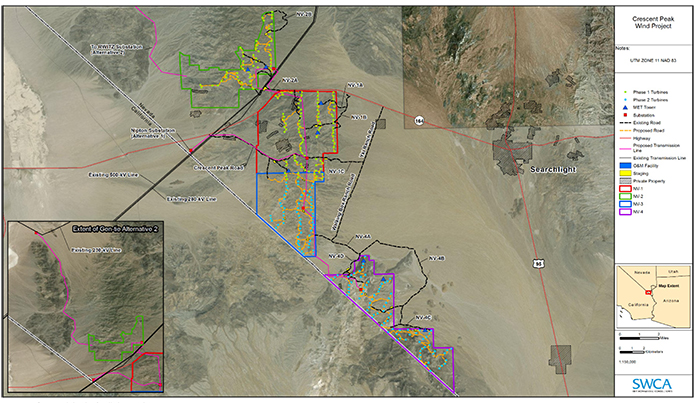
^Map showing potential locations of wind turbines next to national park units, along the California-Nevada border.
Eagle Surveys
May 23, 2016 - The applicant for the Crescent Peak Wind Project is doing eagle surveys right now, according to Bureau of Land Management (personal coomunication), which is not following protocol. Using the contractor SWCA, surveys right now are to look for birds and bats, including eagles. US Fish and Widlife Service protocol for eagle nest surveys calls for surveys to be done in Fall and Winter for this geographic area. This is when eagles are beginning to nest. By May eagles have often flegded and nests may be unoccuppied. The applicant should be undertaking eagle nest surveys starting in November-December-January of 2016.
See:
Wind Project Moving Forward
April 23, 2016 - Crescent Peak Wind Project Update: Eolus Wind has submitted a Draft Notice of Intent (NOI) for the Crescent Peak Wind Project to be reviewed by the Bureau of Land Management. An NOI is the first stage of an official federal review of a big project like this. The BLM has placed the NOI on hold until October 1st, 2016 due to other large pending projects including a land exchange with Nellis AFB. But we could be engaged in this issue this coming fall.
The Crescent Peak Wind Project would be built on Nevada public lands and be adjacent to the Mojave National Preserve and the new Castle Mountains National Monument in California. It would surrond the historic Walking Box Rance and be visible from Searchlight, Nevada. A wind project surrounding Searchlight has been held up due to golden eagle and other wildlife threats.
Digital Imagery of Proposed Crescent Peak Wind Project
March 6, 2016 - Thanks to Shaun Gonzalez for creating these digital images of the proposed wind project from different angles. The 3D turbine model I use is 146 meter hub height, which is consistent with a 3.3MW Vestas turbine.

^Looking at the proposed wind project right of way from Wee Thump Joshua Tree Wilderness Area.
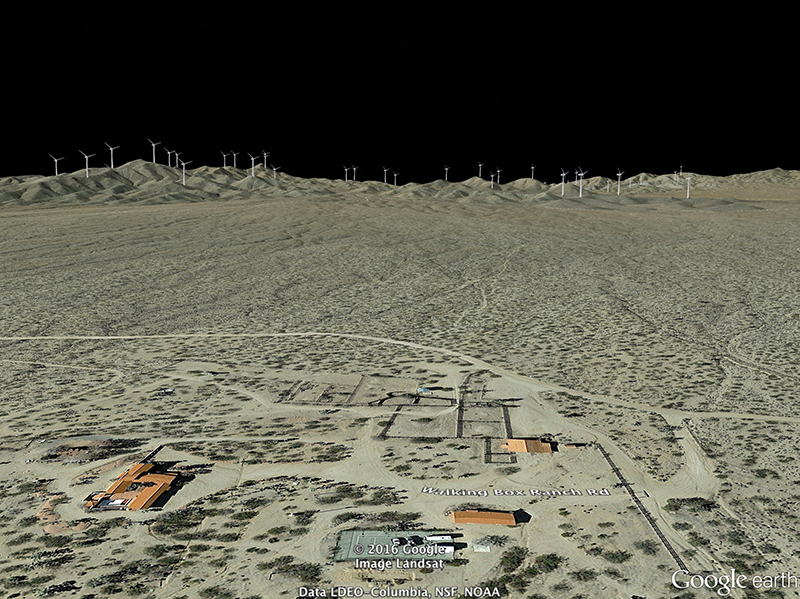
^Looking west from Walking Box Ranch.
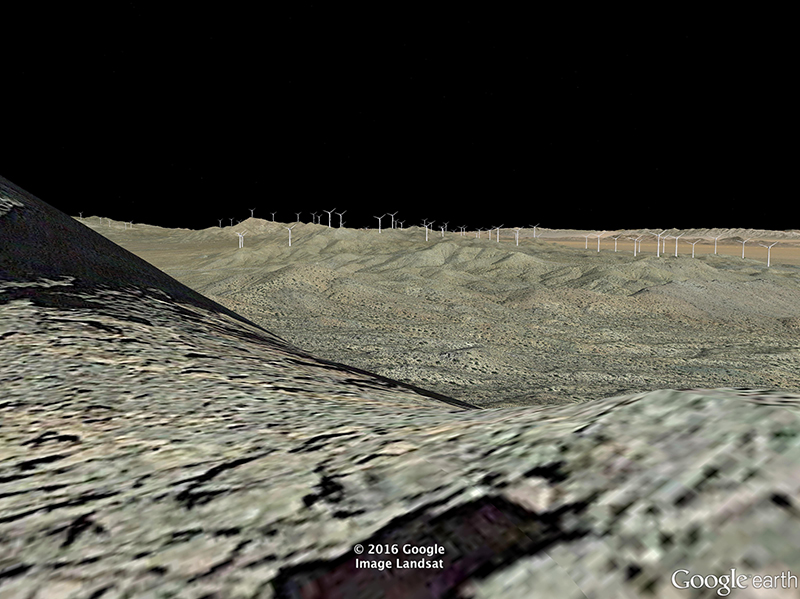
^From the Castle Peaks within the Mojave National Preserve looking roughly northeast into Nevada.
Three New National Monuments in the California Desert
^Looking eastward from the California-Nevada border inside the new Castle Mountains National Monument. A proposed wind project would be placed on the hill to the left if allowed to go forward by Bureau of Land Management.
February 18, 2016 - Castle Mountains National Monument was officially designated on February 12 by President Obama using the Antiquities Act after more than a decade of legislative work by Senator Dianne Feinstein (D-Calif.), as well as advocacy work by many environmental groups. Mojave Trails National Monument, Sand to Snow National Monument, and Castle Mountains will protect 1.8 million acres of desert lands. The Mojave Trails National Monument, at 1.4 million acres, links Mojave National Preserve and Joshua Tree National Park, adding protection for important connectivity corridors for wildflife. All three monuments had proposed large-scale renewable energy projects over the years, so these designations permanently conserve desert ecosystems, cultural resources and history from energy threats.
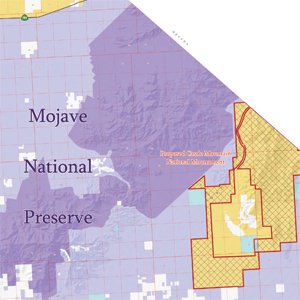
The Castle Mountains were originally carved out of the Mojave National Preserve when it was established because of an operating gold mine, and now 20,900 acres will be added back to a more protected status, managed by both the National Park Service and Bureau of Land Management. Mojave Trails National Monument will be managed by the Bureau of Land Management, and Sand to Snow National Monument will be managed jointly by the Bureau of Land Management and the U.S. Forest Service.
For more on the new national monuments see:
http://www.wildlandsconservancy.org/conservation_mojave.html
http://www.biologicaldiversity.org/campaigns/california_national_monuments/index.html
http://californiadesert.org/the-proposal/monuments/
http://www.calwild.org/three_new_monuments_in_ca_desert
https://www.npca.org/parks/castle-mountains-national-monument
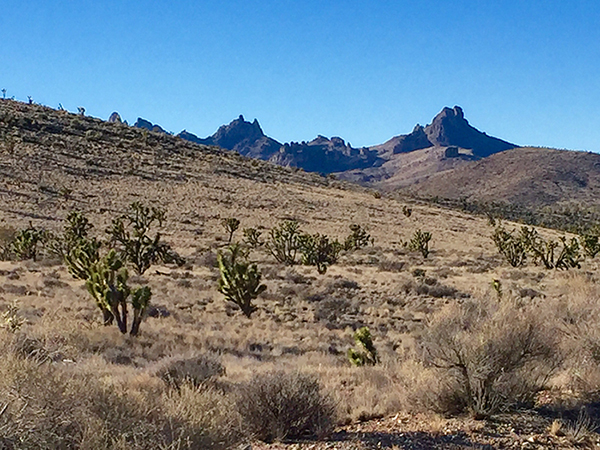
^Castle Peaks.
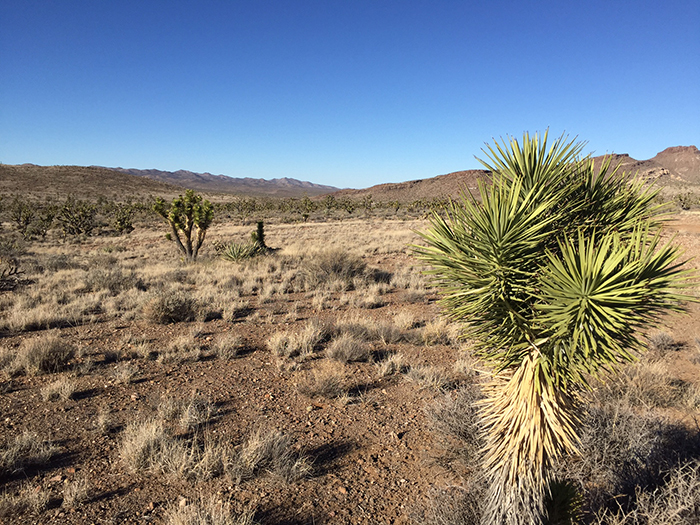
^Looking northward up the Castle Mountains National Monument lands towards the McCullough Range in Nevada.
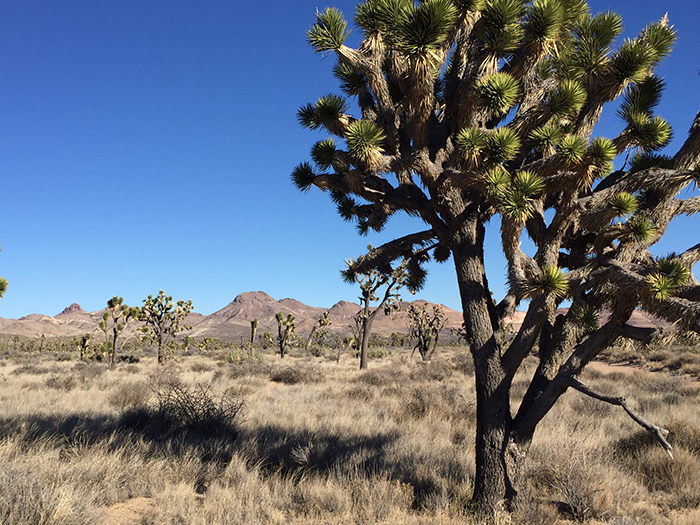
^Joshua tree savanna.

^Buckhorn cholla and native grasses -- galleta grass and grama.
Reactivated Wind Project Threat to Castle Mountains Area
^Crescent Peak in the northern part of the New York Mountains, just outside the boundary of the Mojave National Preserve and adjacent to the proposed Castle Mountains National Monument. This scene is in the heart of a large industrial wind project application which has been reactivated.
February 5, 2016 - Clark County NV - Will there be a wind project next to the proposed Castle Mountains National Monument and Mojave National Preserve? Ironically, the new Castle Mountains National Monument in California, which may be created soon, has a reactivated wind energy application right next to it in Nevada. Eolus Wind has bought the applications for the Crescent Peak Wind Project (and Comstock Wind to the north near Virginia City, NV) and intends to file a Notice of Intent to prepare an Environmental Impact Statement with the Bureau of Land Management soon. The application spans nearly 40,000 acres and would be visible from the Castle Peaks, Wee Thump Wilderness, Walking Box Ranch, several Parts of the Mojave National Preserve, and Spirit Mountain. Eolus is saying they may want to use the newer 750 foot concrete based turbines which would be highly visible form the Mojave National Preserve.
^Joshua trees (Yucca brevifolia) on the wind project site.
The wind proposal would be visible from Nipton, surrounded by the Wee Thump Wilderness and would border the Mojave National Preserve, all hugging the Nevada border. The Bureau of Land Management is expecting a revised plan of development and the company will be undertaking raptor surveys.
^Map of proposed Crescent Peak Wind Project in 2012, by Mojave Desert Blog.
^Joshua trees and yuccas (Yucca schidigera and Y. baccata) grow in a dense blackbrush (Coleogyne ramosissima) scrubland by Crescent Peak.
^Mojave yuccas dot the landscape on the west slope of the northern New York Mountains where the wind application sits. Nipton is within view of this landscape. Looking south from the Nipton-Searchlight road.
^Crescent Peak with blackbrush, Mojave yuccas, catclaw acacias ( Acacia greggii, leafless in winter), and big galleta grass (Hilaria rigida).
The Swedish company Eolus just reactivated a dormant application from Oak Creek Wind and have not yet started the environmental review process.
In order to get the NOI in the Federal Register, they need to submit an updated Plan of Development to BLM which they have not done yet. It will take BLM about 2 months to decide if the plan will will be good enough to start National Environmental Policy Act review.
The project is about 40,000 acres, however, the new owner is saying the final project will be anywhere from 50 to 200 MW.
Standard turbines (450 feet tall) may be considered outdated technology. The utilities are far more interested in photovoltaic solar projects. So this company wants 4 megawatt turbines which would be 750 feet tall. There is a demonstration project using these in Iowa, and we have seen on at Tehachapi Pass in CA. This would be an even larger visual intrusion to surrounding landscapes than older large wind turbine generator models.
Eolus told BLM it would take five years to complete all surveys and they would not start construction until 2021.
^Laura Cunningham of Basin & Range Watch is on the left in this photo by Campaign for the California Desert, helping to write letters to Congress to preserve the area in 2009. Castle Mountains is just to the south of the proposed wind project.
^Public access dirt road on BLM land on the Crescent Peak wind project site; this road would need to be widened for construction traffic. The wind project would also possibly sit on the distant foothills of the McCullough Mountains in the background.
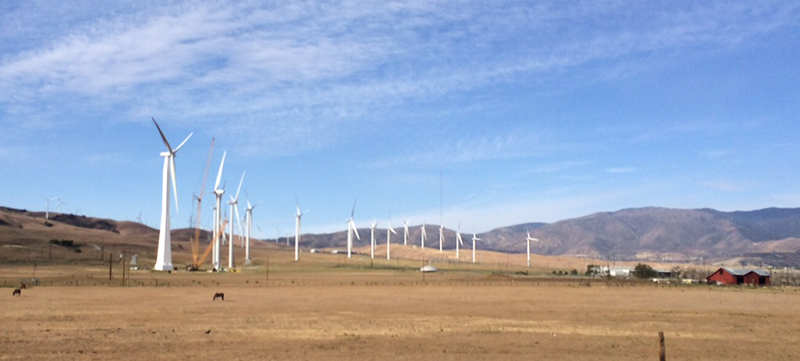
^Very large wind turbine generator on the left under construction on Tehachapi Pass CA, which may be similar to the design sought by Eolus at the Crescent Peak area. These would be visible from a huge distance away.
The BLM said that they may want to use less turbines due to the super size of this new mega-concrete turbine. Eolus told BLM there could be as few as ten for this project. The question is where would they put a small project in that 38,000 acres? Possibly around Crescent Peak. It is full of patented mining claims and active mines, and BLM would consider that the most disturbed area. But even at 4 MW, ten would only give them 40 MW.
The Las Vegas Resource Management Plan noted that the Piute Valley (east of Crescent Peak) should be managed for its solitude and primitive recreation opportunities.
Here is the promotional link: http://nawindpower.com/eolus-acquires-two-nevada-wind-power-projects
Through its recently established North American subsidiary, Sweden-based developer Eolus has acquired two wind power projects under development in Nevada. The transaction means that Eolus will acquire 100% of the shares in the U.S. companies Crescent Peak Renewables LLC and Comstock Wind LLC for the sum of $50,000.
According to Eolus, Crescent Peak owns the rights to a project between 200 MW and 600 MW under development in Clark County, and Comstock owns the right to a project between 20 MW and 100 MW under development in Storey, Washoe and Carson City counties. The transaction includes a profit sharing mechanism for the future sale of the wind projects.

^Two red-tailed hawks wheeling in the skies above Crescent Peak during our visit.
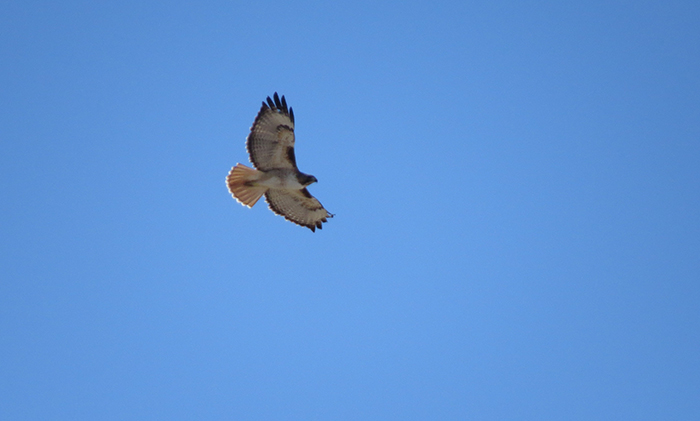
^Red-tailed hawk in the Crescent Peak area.
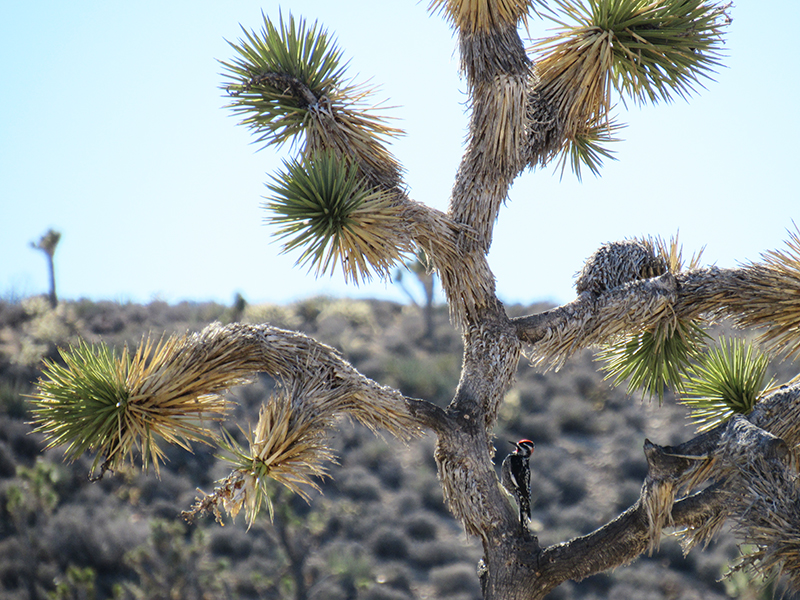
^Red-naped sapsucker on a Joshua tree in the wind project proposal site, Crescent Peak area.
^Crescent Peak with a wash lined with desert almond (Prunus fasciculata) and Apache plume (Fallugia paradoxa).
^Highway connecting Nipton and Searchlight cuts through the wind application which would lie on either side if following the prior application. A transmission line is probably the main reason wind developers find this site attractive.
^Looking west from the northern New York Mountains and highway to Ivanpah Valley and Clark Mountain. The glowing Ivanpah solar power towers are visible in the distance.
^Historic Walking Box Ranch, managed by the BLM, lies on the eastern edge of the proposed wind project.
^Desert tortoise exclusion fence on Walking Box Ranch, looking westward to the Crescent Peak hills where the wind project might lie. The area is managed for tortoises in the Pauite Eldorado Valley.
^Blackbrush and Joshua Trees on the lower hills of the proposed project site, looking towards Wee Thump Joshua Tree Wilderness.
Mojave National Preserve Threat

^Castle Peaks.
January 7, 2013 - The Oak Creek Energy Systems (OCES) application to the Bureau of Land Management (BLM), Las Vegas Field Office, for a right of way grant to conduct meteorological studies on public lands, was approved a few years ago. The application involves the installation of meteorological towers to collect atmospheric data for a period of 2 to 3 years, about 10 miles west of the town of Searchlight, Nevada. OCES will collect data on wind speed and direction, wind shear, temperature, and humidity.
The project is located in the Castle Mountain area on the Clark County, Nevada-San Bernardino County, California boundary, bordering the Piute-Eldorado Valley Area of Critical Environmental Concern and several wilderness areas. We called BLM and they said it will also go into California. It will be adjacent to the Mojave National Preserve in the Castle Peaks mine area, in the keyhole next to the preserve.
Originally, there was a sister project to this one in the Castle Mountains keyhole in the preserve on the California side by the same company. That was thrown out. Now it is all in Nevada, but it will still be visible for hundreds of miles in the Preserve.
As of September 2012, the company changed to Crescent Peak Renewables LLC, a subsidiary of Oak Creek Energy Co. It determined that there might be feasible wind resources to develop a wind farm which would cover 37,740 acres next to Nipton, California, the Wee Thump Wilderness Area in Nevada, the McCullough Mountains Wilderness Area in Nevada, and the wind project would sit directly on a large portion of the northwest border of the Mojave National Preserve in California. The wind turbines would be visible both day and night from great distances the Mojave Preserve. At this point they are submitting their project for review under the Nevada Public Utilities Commission. This indicates that they are attempting to move forward with the Federal Review Process. The BLM has told us that this could make its way in the Federal Register soon.
See the April 2012 Plan of Development >>here (2.68 pdf). The file was scanned upside down and given to us; you may use Adobe Acrobat reader tools of rotating the page clockwise twice to read it in the correct view.

^The most recent project map we have found. The project was removed from the "keyhole" within the Mojave National Preserve, but still lies next to the northeastern boundary.
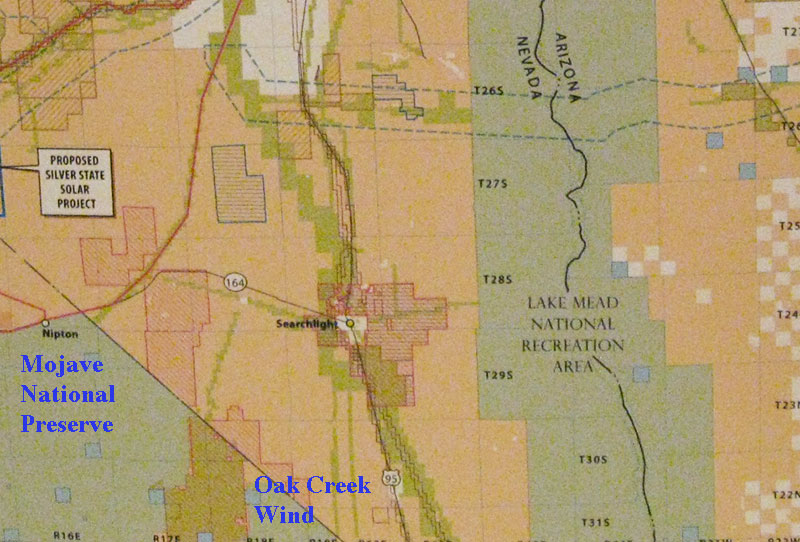
^An older out-of-date map of southern Nevada showing the cumulative project impacts to public lands. Wind projects are red polygons.
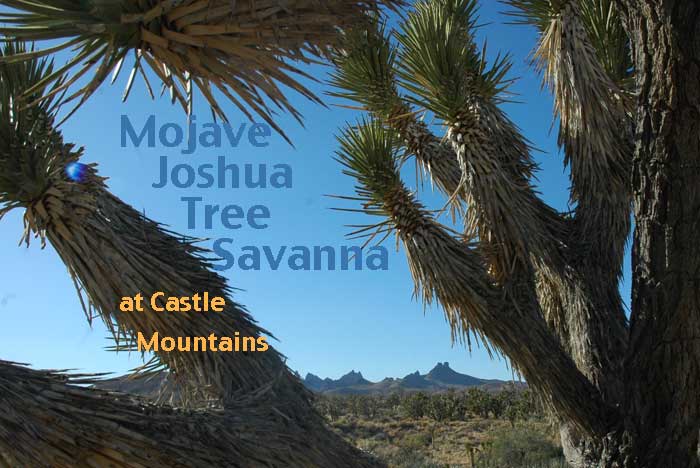
The Castle Mountains area contains unique habitats called Monsoonal Mojave Grassland and Joshua Tree Savanna, found almost nowhere else in the desert. The area is rich in summer-flowering grasses usually found in the Southwest Deserts of Arizona, New Mexico, and Mexico. There are also Great Plains elements. All these mix with typical Mojave Desert plants, and well-developed Joshua tree (Yucca brevifolia) and Mojave yucca (Y. schidigera) stands.
Several species of Grama grasses (Bouteloua eriopoda, B. gracilis, B. barbata B. curtipendula) and Three-awn grasses (Aristida purpurea purpurea, A. p. longiseta) grow with Big galleta grass (Hilaria rigida), Bush muhly (Muhlenbergia porteri), Indian rice grass (Stipa hymenoides), Desert needlegrass (Stipa speciosa).
Shrubs are very diverse, and include not only Creosote bush (Larrea tridentata), but also Winterfat (Krascheninnikovia lanata), Apache plume (Fallugia paradoxa), Ephedra (Ephedra spp.), Paperbag bush (Salazaria mexicana), Cliff rose (Purshia mexicana), California buckwheat (Eriogonum fasciculatum), Blackbrush (Coleogyne ramosissima), Wolfberry (Lycium spp.), Four-wing saltbush (Atriplex canescens), Desert almond (Prunus fasciculata), Matchweed (Gutierrezia sp.), and Desert sage (Salvia dorrii). Washes have White bursage (Ambrosia dumosa), Cheesebush (Hymenoclea salsola), and Desert willow (Chilopsis linearis).
A savanna of Joshua trees and some juniper grow in the grassy hills and valleys. Both Mojave yucca and Banana yucca (Yucca baccata) grow with cacti: Calico cactus (Echinocereus engelmannii), Buckhorn cholla (Cylindropuntia acanthocarpa), Pancake prickly-pear (Opuntia chlorotica), and Old man cactus (Opuntia erinacea).
On our field trip in October 2009 we saw Rock wrens, Gambel's quail, and Barn swallows and Violet-green swallows flying. Bighorn sheep use the area, and the park is considering re-introducing Pronghorn antelope to the grassland.
Environmental groups such as the California Wilderness Coalition and National Parks and Conservation Association are working to request Congress to add this "keyhole" area surrounded by parkland to Mojave National Preserve. Such a rich ecosystem deserves protection. It is currently managed by Bureau of Land Management with a played-out open-pit gold mine -- the Viceroy Mine -- that could be interpreted by the park for its historic value. The mine area could be reclaimed. The 30,000 acres of the Castle Mountains area must be made part of the park by an act of Congress, and letters to congressmen can help to make this happen.




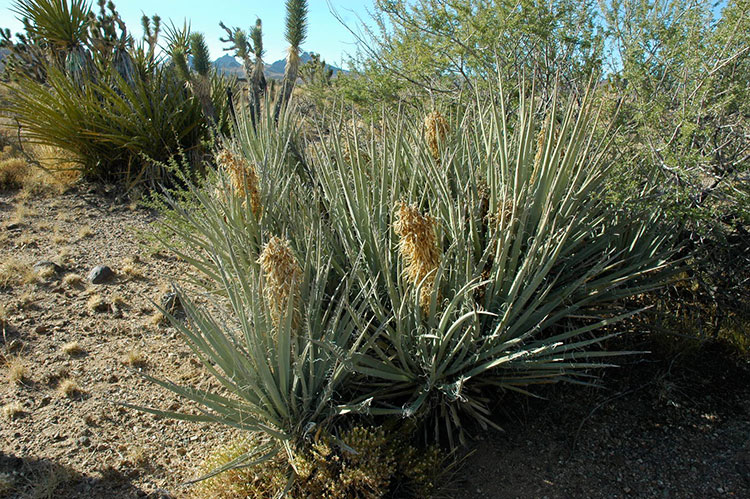
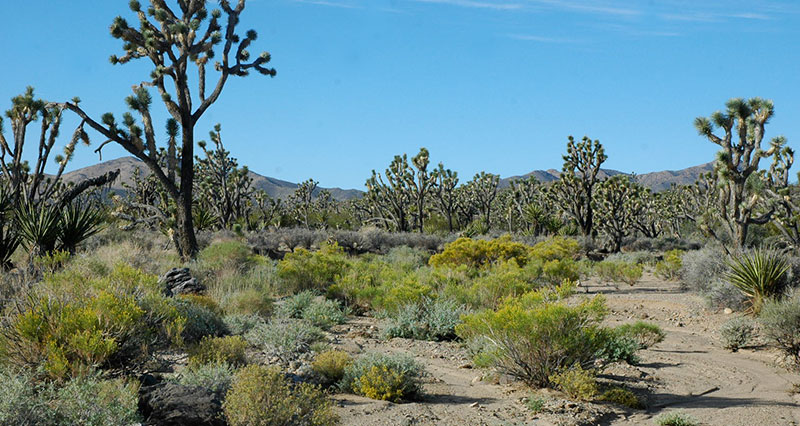
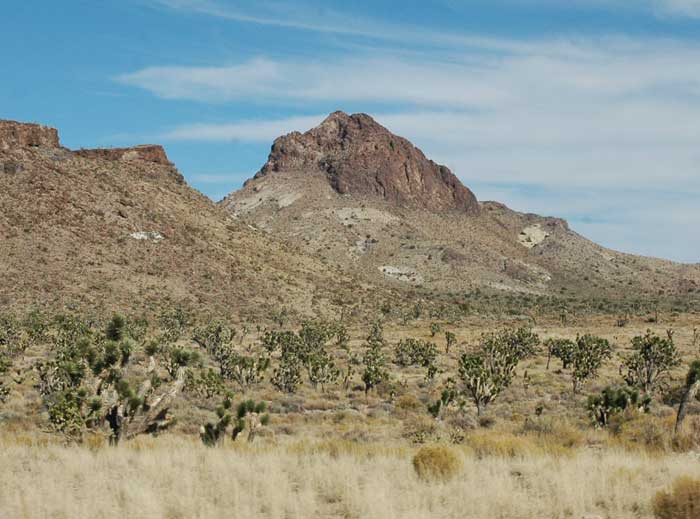
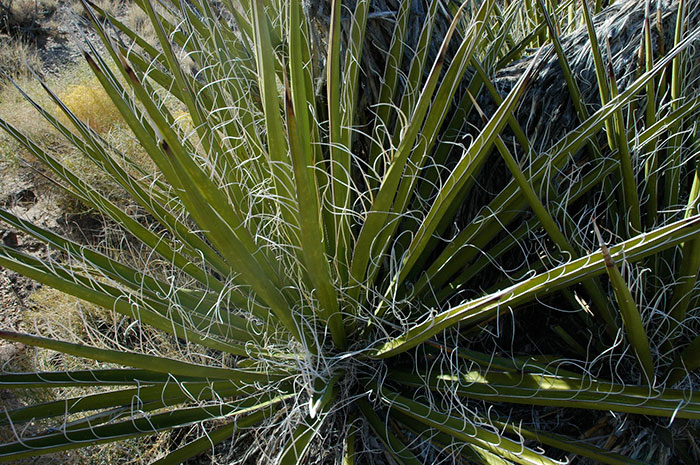
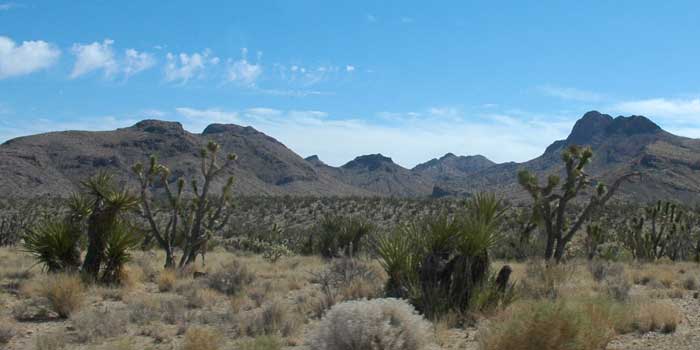



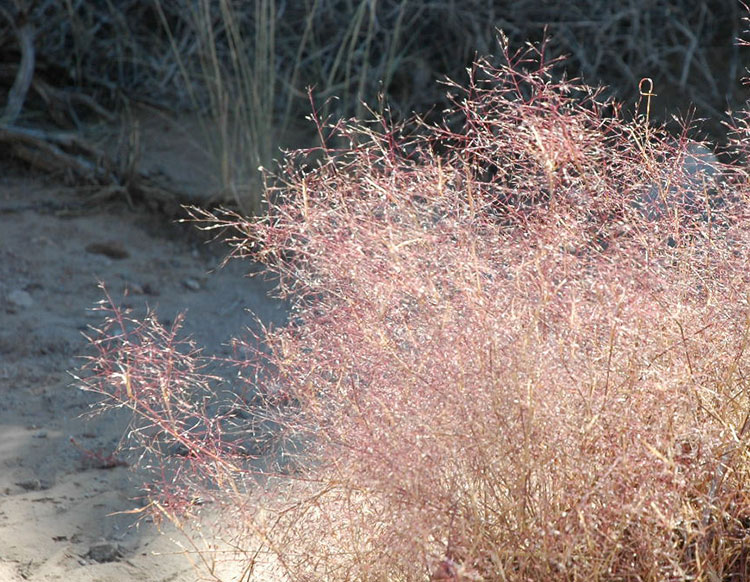
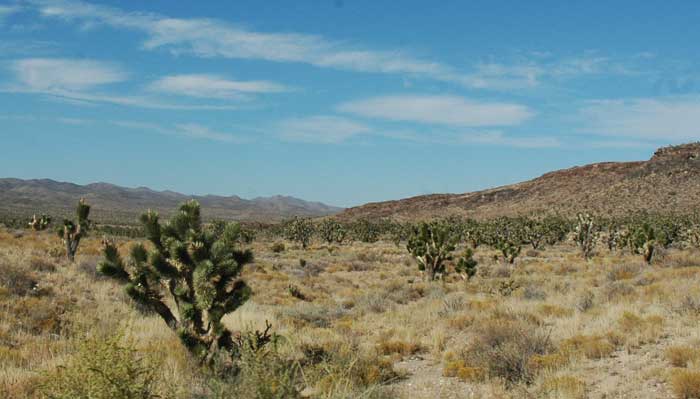
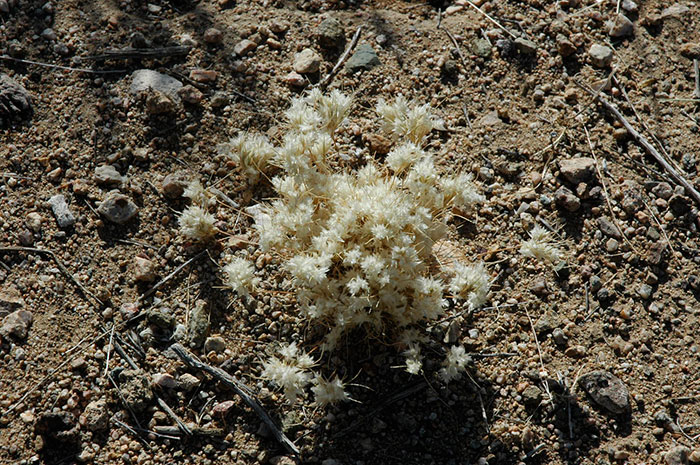
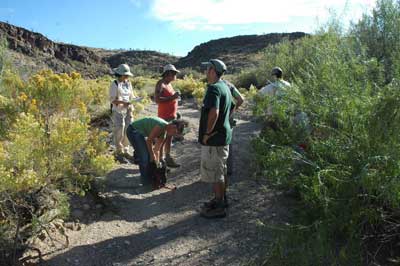
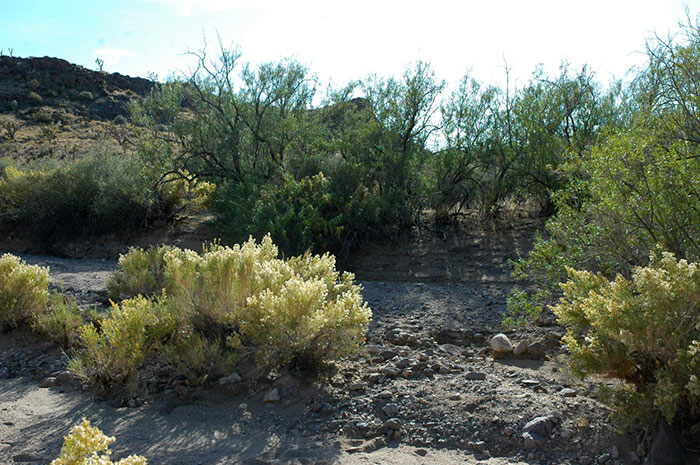
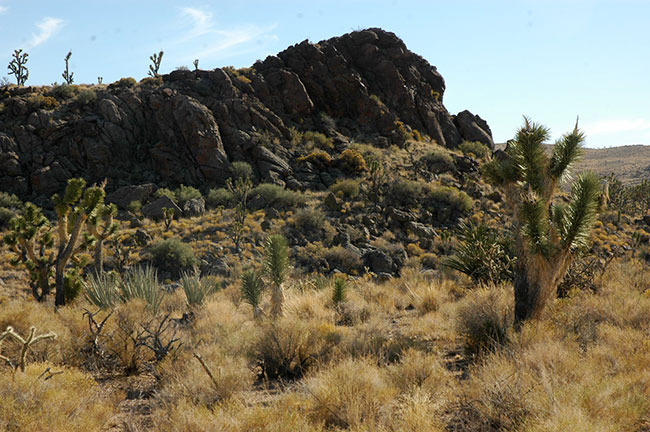
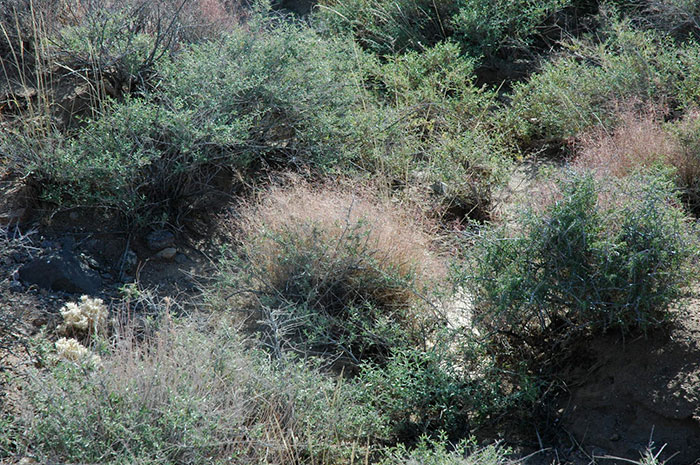

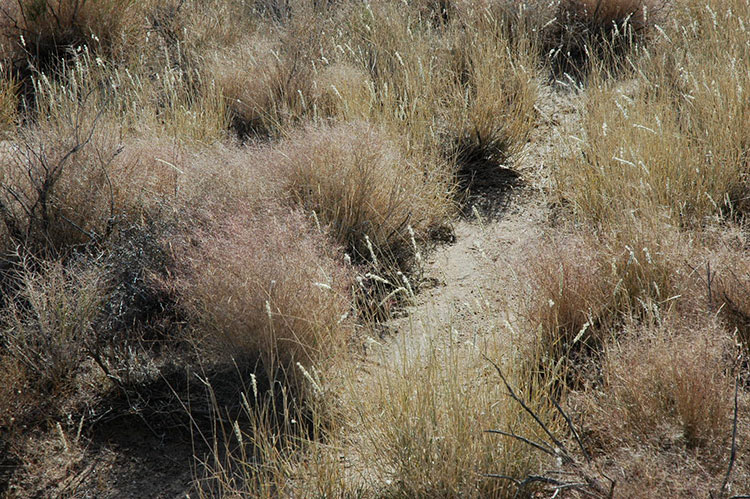

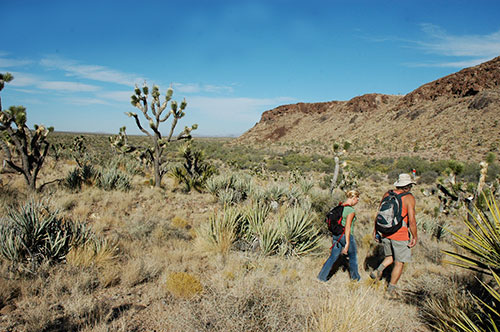
HOME.....Freedom of Information Request.....Searchlight Wind Project
